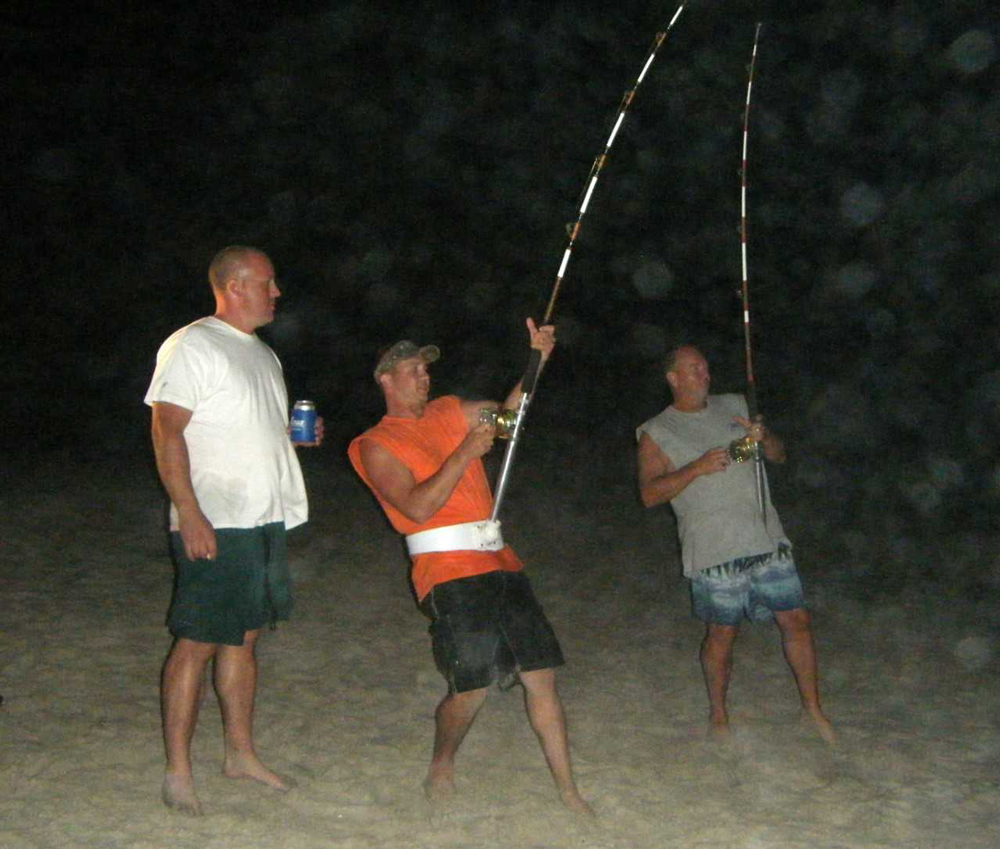Summer is a season when everyone seems to get what they want: offshore waters are prime for tuna trolling, fly-fishermen up towards the Gunpowder and Savage rivers are enjoying the last few bits of dry-fly and Tenkara fishing action, freshwater anglers are in the midst of trying to catch bass when mild days present themselves, and Bay anglers have plenty of schoolie summer stripers to chase. But what about us surf-casters? The bluefish have all but retreated to New England waters along with their striper counterparts. The big-name species are gone, leaving many to stow their surf rods for the summer until the red drum make their annual commotion along the shores of Assateague Island. You could follow suit, or, if you’re night-owl like me, take advantage of the beasts that lurk around off the DelMarVa beaches during the hottest months of the summer: sharks.

What’s in the Surf
Shark have long been a standard for Mid-Atlantic fisherman. Mako Madness is one of the first official events that kicks off the tournament season for the region. The largest fish ever taken by rod and reel in Maryland was Grace Czerniak’s 1,201 pound Tiger Shark, who’s record still stands to this day after over 20 years. The species are a bit more limited near the surf line, with blacktip, dogfish, and sand tigers being common. Many tourists would like to forget the presence of such cartilaginous predators swimming near their children. On the flipside, surf anglers tend to forget about their presence as well. They’re often hit or miss, and hitting during the wee hours of the night is the norm. You may see the tip of your rod double-over in 15 minutes or less, or you might be out on the beach shivering until 3 a.m. with no stories of grandeur to take home – rotten bait and sore eyes will be your only reward. But those who have the mental persistence to stare at a surf-rod spread with the dim white light of a headlamp will eventually be rewarded with a fine catch.
Surf Fishing Gear to Fear
If you were to sum up land-based shark fishing in one sentence, it would be “Throw a big bait, with a big hook, and wait for a shark.” With this mantra, anyone can sit on the beach and eventually end up with a memorable fight. However, the formula for success is definitely in the specifics. Contrary to popular belief, extremely robust tackle is not necessary here. As long as you’re targeting shore-bound sharks species, you’ll be just fine with your medium to heavy action surf rod and a high-capacity reel outfitted with 50-pound braid or the poundage of your choice. The thin diameter of braid line greatly increases the range of your casts.
Anglers seeking to skip the rigging process can buy pre-built rigs at a variety of tackle shops. They’re usually cheap, accessible, and very easy to use. Fenwick Bait and Tackle is a prime example. They have a range of pre-built rigs for bluefish to sharks, and a wide selection of fresh bait to boot. Three-way swivels have arguably become the saving grace of terminal tackle in the surf. Each point has its role. First, connect your line to the swivel using your favorite knot. Next, tie up a piece of brawny mono about eight inches in length. At the end, tie on your preferred weight. Weights come in all shapes and sizes, but hurricanes hold the best in my experiences. About five ounces will do on most nights. In some cases, you’re better off tying a snap-swivel to end of your mono for an easy swap when it’s time to tag-in a heavier weight when the surf and/or wind picks up. The last port on the swivel is reserved for two feet or so of Tooth-Proof or other rated single-strand wire. I can’t stress this next part enough: Single-strand wire kinks. If it does kink, the integrity will drop dangerously. This goes especially for tying a haywire-twist to your hook. Learn to do these twists beforehand, and practice! Your fingers will get a work-out, but a good haywire-twist in unkinked wire will stand its ground against your quarry.
Reels that are equipped with a baitrunner option, such as the Shimano BTR 4500B, have a distinct advantage when it comes to shark fishing. After plunging your surf rod back into its PVC throne to lie in wait, flip on the baitrunner. This allows the drag to automatically release line in an even fashion when tension is applied, without causing a bird’s nest. The shark feels no drag pressure, and will warrant a confident eat, leaving you, the angler, with a firm hook set.
Which leads to the hook – this is your primary connection to the shark. It being the first of many components, it must be more unyielding as the sand tiger that engulfs it. As the mantra states, the recipe calls for a substantial hook. Remember, surf sharking is usually catch and release so your hooks should be non-offset circle hooks. Size isn’t quite dictated by the size of the shark, rather the size of your intended bait. Tuna heads and the like will need 10/0 or larger, complete with a second hook. If you opt for the lighter side, such as bluefish chunks, 5/0 should do the trick.

The Shark Bait Debate
Bait is another important part of surf fishing for sharks. Options include the variety of medium-sized baitfish offered at the local bait and tackle shops. Menhaden are an obvious choice, with their oil being a prime ingredient in enticing sharks to the vicinity. Bluefish also come to mind. Being an occasional bycatch, you’ll have means to produce your own bait. Remember, the fresher the better. It all comes down to how stinky and bloody your baitfish is. The more oils, blood, digestive fluids, and scent released into the current, the greater the chances for feeling the massive head-shakes that come with a shark fight.
Filleting the bait may seem ok, but you tend to waste a great bit of potential. Cutting the whole fish into chunks (discarding the tail) and leaving the hook barb protruding, the chunk will provide better hook-sets and the strength to hang on during long casts.
Long, cool summer nights are ready to be dedicated to staring at the rod tips’ ebb and flow, back and forth with the waves. When that first shark doubles-over your favorite St. Croix, your hard work will have paid off. Rig it right. Don’t skimp on any part of the process. If you’ve got the patience and a big bait with an even bigger hook, it’s just a matter of time until you’ve released your first shark in the surf.
- By Parker Martin
WARNING: Barred from the Beach
Some beach towns have put the foot down on chumming or blood-baiting sharks close to shore. Furthermore, any means of propelling the bait other than casting (such as with a kayak) may be illegal in certain areas. Be sure to check the local regulations, before heading out.
Shark Conservation
Catch and release is the name of the game for shark fishing. Anglers that are interested and willing to help can get involved with NOAA’s Apex Predator Tagging Program. For anglers looking to tag their catches, check out their program on NOAA’s website. They offer an excellent program for fishermen that want to make a difference.
If you have a boat and want to try shark fishing out in the open ocean, check out Mako Shark Fishing Tune Up, to learn how it's done.